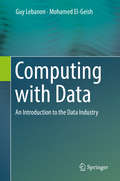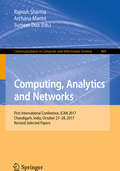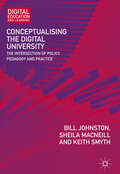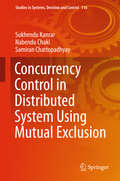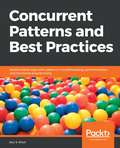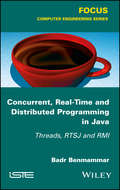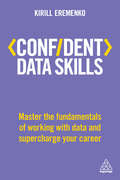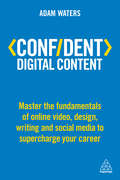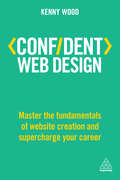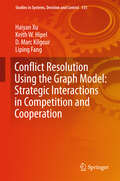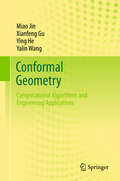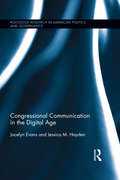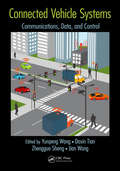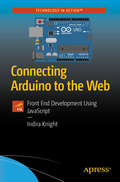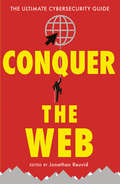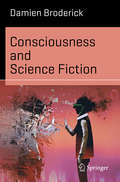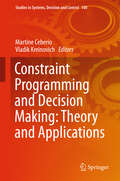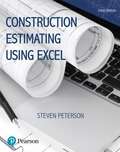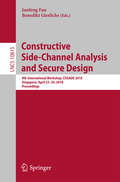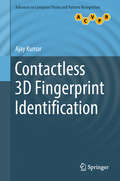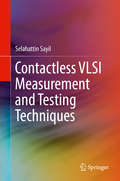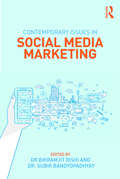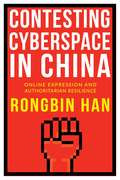- Table View
- List View
Computing with Data: An Introduction to the Data Industry
by Guy Lebanon Mohamed El-GeishThis book introduces basic computing skills designed for industry professionals without a strong computer science background. Written in an easily accessible manner, and accompanied by a user-friendly website, it serves as a self-study guide to survey data science and data engineering for those who aspire to start a computing career, or expand on their current roles, in areas such as applied statistics, big data, machine learning, data mining, and informatics. The authors draw from their combined experience working at software and social network companies, on big data products at several major online retailers, as well as their experience building big data systems for an AI startup. Spanning from the basic inner workings of a computer to advanced data manipulation techniques, this book opens doors for readers to quickly explore and enhance their computing knowledge. Computing with Data comprises a wide range of computational topics essential for data scientists, analysts, and engineers, providing them with the necessary tools to be successful in any role that involves computing with data. The introduction is self-contained, and chapters progress from basic hardware concepts to operating systems, programming languages, graphing and processing data, testing and programming tools, big data frameworks, and cloud computing. The book is fashioned with several audiences in mind. Readers without a strong educational background in CS--or those who need a refresher--will find the chapters on hardware, operating systems, and programming languages particularly useful. Readers with a strong educational background in CS, but without significant industry background, will find the following chapters especially beneficial: learning R, testing, programming, visualizing and processing data in Python and R, system design for big data, data stores, and software craftsmanship.
Computing, Analytics and Networks: First International Conference, ICAN 2017, Chandigarh, India, October 27-28, 2017, Revised Selected Papers (Communications in Computer and Information Science #805)
by Sumeet Dua Rajnish Sharma Archana MantriThis book constitutes the revised selected papers from the First International Conference on Computing, Analytics and Networks, ICAN 2017, held in Rajpura, India, in October 2017.The 20 revised full papers presented in this volume were carefully reviewed and selected from 56 submissions. They are organized in topical sections on Mobile Cloud Computing; Big Data Analytics; Secure Networks.Five papers in this book are available open access under a Creative Commons Attribution 4.0 International License via link.springer.com. For further details, please see the copyright page.
Conceptualising the Digital University: The Intersection of Policy, Pedagogy and Practice (Digital Education and Learning)
by Bill Johnston Sheila MacNeill Keith SmythDespite the increasing ubiquity of the term, the concept of the digital university remains diffuse and indeterminate. This book examines what the term 'digital university' should encapsulate and the resulting challenges, possibilities and implications that digital technology and practice brings to higher education. Critiquing the current state of definition of the digital university construct, the authors propose a more holistic, integrated account that acknowledges the inherent diffuseness of the concept. The authors also question the extent to which digital technologies and practices can allow us to re-think the location of universities and curricula; and how they can extend higher education as a public good within the current wider political context. Framed inside a critical pedagogy perspective, this volume debates the role of the university in fostering the learning environments, skills and capabilities needed for critical engagement, active open participation and reflection in the digital age. This pioneering volume will be of interest and value to students and scholars of digital education, as well as policy makers and practitioners.
Concurrency Control in Distributed System Using Mutual Exclusion (Studies in Systems, Decision and Control #116)
by Nabendu Chaki Sukhendu Kanrar Samiran ChattopadhyayThe book presents various state-of-the-art approaches for process synchronization in a distributed environment. The range of algorithms discussed in the book starts from token based mutual exclusion algorithms that work on tree based topology. Then there are interesting solutions for more flexible logical topology like a directed graph, with or without cycle. In a completely different approach, one of the chapters presents two recent voting-based DME algorithms. All DME algorithms presented in the book aim to ensure fairness in terms of first come first serve (FCFS) order among equal priority processes. At the same time, the solutions consider the priority of the requesting processes and allocate resource for the earliest request when no such request from a higher priority process is pending.
Concurrent Patterns and Best Practices: Build scalable apps with patterns in multithreading, synchronization, and functional programming
by Atul S. KhotA definitive guide to mastering and implementing concurrency patterns in your applicationsKey FeaturesBuild scalable apps with patterns in multithreading, synchronization, and functional programmingExplore the parallel programming and multithreading techniques to make the code run fasterEfficiently use the techniques outlined to build reliable applicationsBook DescriptionSelecting the correct concurrency architecture has a significant impact on the design and performance of your applications. This book explains how to leverage the different characteristics of parallel architecture to make your code faster and more efficient. To start with, you'll understand the basic concurrency concepts and explore patterns around explicit locking, lock free programming, futures & actors. Then, you'll get insights into different concurrency models and parallel algorithms and put them to practice in different scenarios to realize your application's true potential. We'll take you through multithreading design patterns, such as master, slave, leader, follower, map-reduce, and monitor, also helping you to learn hands-on coding using these patterns. Once you've grasped all of this, you'll move on to solving problems using synchronizer patterns. You'll discover the rationale for these patterns in distributed & parallel applications, followed by studying how future composition, immutability and the monadic flow help create more robust code. Toward the end of the book, you'll learn about the actor paradigm and actor patterns - the message passing concurrency paradigm.What you will learnExplore parallel architecture Get acquainted with concurrency models Internalize design themes by implementing multithreading patterns Get insights into concurrent design patterns Discover design principles behind many java threading abstractions Work with functional concurrency patternsWho this book is forThis is a must-have guide for developers who want to learn patterns to build scalable and high-performing apps. It’s assumed that you already have a decent level of programming knowledge.
Concurrent, Real-Time and Distributed Programming in Java: Threads, RTSJ and RMI
by Badr BenmammarThis book provides an introduction to concurrent, real-time, distributed programming with Java object-oriented language support as an algorithm description tool. It describes in particular the mechanisms of synchronization (cooperative and competitive) and sharing of data (internal class, static variables) between threads in Java. He then discusses the use of Java for real-time applications. Consequently, a presentation of the RTSJ (Real Time Specification for Java) specification dedicated to the development of real-time applications in Java is also introduced in this book. Finally, a presentation of programming distributed in Java is presented in this book. We are particularly interested in communication using the TCP Sockets and high-level communication using Java Remote Method Invocation (RMI). The book also contains an annex which contains a practical set of application exercises in relation to the theme of the book. Knowledge of the Java language is a prerequisite for understanding the book.
Confident Data Skills: Master the Fundamentals of Working with Data and Supercharge Your Career (Confident Series)
by Kirill Eremenko<p>Data science is the most exciting skill you can master. Data has dramatically changed how our world works. From entertainment to politics, from technology to advertising and from science to the business world, data is integral and its only limit is our imagination. If you want to have a vibrant and valuable professional life, being skilled with data is the key to a cutting-edge career. Learning how to work with data may seem intimidating or difficult but with <i>Confident Data Skills</i> you will be able to master the fundamentals and supercharge your professional abilities. This essential book covers data mining, preparing data, analysing data, communicating data, financial modelling, visualizing insights and presenting data through film making and dynamic simulations. <p>In-depth international case studies from a wide range of organizations, including Netflix, LinkedIn, Goodreads, Deep Blue, Alpha Go and Mike's Hard Lemonade Co. show successful data techniques in practice and inspire you to turn knowledge into innovation. <i>Confident Data Skills</i> also provides insightful guidance on how you can use data skills to enhance your employability and improve how your industry or company works through your data skills. Expert author and instructor, Kirill Eremenko, is committed to making the complex simple and inspiring you to have the confidence to develop an understanding, adeptness and love of data.</p>
Confident Digital Content: Master the Fundamentals of Online Video, Design, Writing and Social Media to Supercharge Your Career (Confident Series)
by Adam Waters<p><i>Confident Digital Content</i> gives you the opportunity to become digitally multi-skilled and learn the fundamentals of the most important types of digital creativity. Whatever your career path, being able to produce exciting and creative content online, whether through video, design, digital journalism or social media, can supercharge your professional career and empower your entrepreneurial pursuits. <p><i>Confident Digital Content</i>teaches you valuable hard skills, including how to create and upload great video content, graphic design, photography for social media, community management, digital strategy and metrics, and helps you learn them through practical exercises in every chapter. It also provides insightful guidance on how to boost your career and employability by honing your leadership, creativity and entrepreneurial skills in the world of digital. Case studies from inspiring individuals at organizations including CNN International, Mumsnet, Bunster's Hot Sauce, HuffPost UK, and Crocstar Media show you real world examples of excellent digital content in practice. This book is your ultimate guide to achieving the technical proficiency and confidence to start an inspiring digital career path, whether your ambition is to rise to the top of your chosen industry, be a successful freelancer or become an entrepreneur.</p>
Confident Web Design: Master the Fundamentals of Website Creation and Supercharge Your Career (Confident Series)
by Kenny Wood<p>This is your ultimate beginner's guide to the skills of web design. <i>Confident Web Design</i> takes you on a practical journey during which you will discover the techniques to allow you to publish a basic website from scratch. Whether you want to develop web design skills to set yourself apart in a competitive job market, power your entrepreneurial pursuits by creating a new website to showcase your product or business idea, or simply boost your professional performance in your current job, <i>Confident Web Design</i> is the perfect beginner's resource. <p>In <i>Confident Web Design</i>, each chapter is supported by exclusive online exercises to allow you to put your knowledge into practice and perfect the techniques. The book's structure is designed to break down each skill into manageable chunks, aided by helpful examples, technical term glossaries, tables and images to support you as you learn. Written in accessible and engaging language, author Kenny Wood shares his passion and enthusiasm for modern web design through this essential guide. <p>Online Resources include practical exercises for readers to test out their new skills and consolidate their learning.</p>
Conflict Resolution Using the Graph Model: Strategic Interactions in Competition and Cooperation (Studies in Systems, Decision and Control #153)
by D. Marc Kilgour Keith W. Hipel Liping Fang Haiyan XuThis cutting-edge book presents the theory and practice of the Graph Model for Conflict Resolution (GMCR), which is used for strategically investigating disputes in any field to enable informed decision making. It clearly explains how GMCR can determine what is the best a particular decision maker (DM) can independently achieve in dynamic interaction with others. Moves and counter-moves follow various stability definitions reflecting human behavior under conflict. The book defines a wide range of preference structures to represent a DM’s comparisons of states or scenarios: equally preferred, more or less preferred; unknown; degrees of strength of preference; and hybrid. It vividly describes how GMCR can ascertain whether a DM can fare even better by cooperating with others in a coalition. The book portrays how a conflict can evolve from the status quo to a desirable resolution, and provides a universal design for a decision support system to implement the innovative decision technologies using the matrix formulation of GMCR. Further, it illustrates the key ideas using real-world conflicts and supplies problems at the end of each chapter. As such, this highly instructive book benefits teachers, mentors, students and practitioners in any area where conflict arises.
Conformal Geometry: Computational Algorithms And Engineering Applications (Advanced Lectures In Mathematics Ser.)
by Ying He Miao Jin Xianfeng Gu Yalin WangThis book offers an essential overview of computational conformal geometry applied to fundamental problems in specific engineering fields. It introduces readers to conformal geometry theory and discusses implementation issues from an engineering perspective.The respective chapters explore fundamental problems in specific fields of application, and detail how computational conformal geometric methods can be used to solve them in a theoretically elegant and computationally efficient way. The fields covered include computer graphics, computer vision, geometric modeling, medical imaging, and wireless sensor networks. Each chapter concludes with a summary of the material covered and suggestions for further reading, and numerous illustrations and computational algorithms complement the text.The book draws on courses given by the authors at the University of Louisiana at Lafayette, the State University of New York at Stony Brook, and Tsinghua University, and will be of interest to senior undergraduates, graduates and researchers in computer science, applied mathematics, and engineering.
Congressional Communication in the Digital Age (Routledge Research in American Politics and Governance)
by Jocelyn Evans Jessica M. HaydenCommunication defines political representation. At the core of the representational relationship lies the interaction between principal and agent; the quality of this relationship is predicated upon the accessibility of effective channels of communication between the constituent and representative. Over the past decade, congressional websites have become the primary way constituents communicate with their members and a prominent place for members to communicate with constituents. Yet, as we move toward the third decade of the 21st century, little work has systematically analyzed this forum as a distinct representational space. In this book, Jocelyn Evans and Jessica Hayden offer a fresh, timely, and mixed-methods approach for understanding how the emergence of virtual offices has changed the representational relationship between constituents and members of Congress. Utilizing strong theoretical foundations, a broad historical perspective, elite interviews, and rich original datasets, Evans and Hayden present evidence that virtual offices operate as a distinct representational space, and they demonstrate that their use has resulted in unprecedented and ill-understood changes in representational behavior. Congressional Communication in the Digital Age contributes to the scholarship on representation theory and its application to the contemporary Congress. It is valuable reading for students and researchers interested in American politics, political communication, and legislative politics.
Connected Vehicle Systems: Communication, Data, and Control
by Zhengguo Sheng Yunpeng Wang Daxin Tian Wang JianConnected vehicles and intelligent vehicles have been identified as key technologies for increasing road safety and transport efficiency. This book presents and discusss the recent advances in theory and practice in connected vehicle systems. It covers emerging research that aims at dealing with the challenges in designing the essential functional components of connected vehicles. Major topics include intra- and inter-vehicle communications, mobility model of fleet and ramp merging, trace and position data analysis, security and privacy.
Connecting Arduino to the Web: Front End Development Using JavaScript
by Indira KnightCreate physical interfaces that interact with the Internet and web pages. With Arduino and JavaScript you can create interactive physical displays and connected devices that send data to or receive data from the web. You'll take advantage of the processes needed to set up electronic components, collect data, and create web pages able to interact with electronic components.Through exercises, projects, and explanations, this book will give you the core front end web development and electronics skills needed to create connected physical interfaces and build compelling visualizations with a range of JavaScript libraries.By the end of the book you will have developed fully working interactive prototypes capable of sending data to and receiving data from a physical interface. Most importantly, Connecting Arduino to the Web will give you a taste of what is possible and the knowledge to create your own connected physical interfaces and bring the web into your electronics projects.What You'll LearnBuild an Internet of Things dashboard that updates with electronics attached to an ArduinoUse components to interact with online 3D displaysCreate web pages with HTML and CSSSet up a Node.js serverUse WebSockets to process live dataInteract with scalable vector graphics (SVG)Who This Book Is ForTechnologists, developers, and enthusiasts looking to extend their skills, be able to develop physical prototypes with connected devices, and with an interest in getting started with IoT. Also, those excited by the possibilities of connecting the physical and the web.
Conquer the Web: The Ultimate Cybersecurity Guide
by Jonathan Reuvid Nick Wilding Tim Mitchell Maureen Kendal Nick IoannouTons of malicious content floods the internet which can compromise your system and your device, be it your laptop, tablet or phone. <P><P> How often do you make payments online? Do you have children and want to ensure they stay safe online? How often do you sit at a coffee shop and log onto their free WIFI? How often do you use social media on the train or bus? If you believe using an antivirus software will keep devices safe... you are wrong. This book will guide you and provide solutions to avoid common mistakes and to combat cyber attacks. This Guide covers areas such as: <P><P> Building resilience into our IT Lifestyle Online Identity Cyber Abuse: Scenarios and Stories Protecting Devices Download and share Gaming, gamble and travel Copycat websites I Spy and QR Codes Banking, apps and Passwords
Consciousness and Science Fiction (Science and Fiction)
by Damien BroderickScience fiction explores the wonderful, baffling and wildly entertaining aspects of a universe unimaginably old and vast, and with a future even more immense. It reaches into that endless cosmos with the tools of rational investigation and storytelling. At the core of both science and science fiction is the engaged human mind--a consciousness that sees and feels and thinks and loves. But what is this mind, this aware and self-aware consciousness that seems unlike anything else we experience? What makes consciousness the Hard Problem of philosophy, still unsolved after millennia of probing? This book looks into the heart of this mystery - at the science and philosophy of consciousness and at many inspiring fictional examples - and finds strange, challenging answers.The book's content and entertaining style will appeal equally to science fiction enthusiasts and scholars, including cognitive and neuroscientists, as well as philosophers of mind. It is a refreshing romp through the science and science fiction of consciousness.
Consciousness: A Ladybird Expert Book (The Ladybird Expert Series #29)
by Hannah CritchlowPart of the ALL-NEW LADYBIRD EXPERT SERIES.____________Are other animals, or even plants, conscious?Can we create conscious robots?Are we able to assume the consciousness of someone else?We all experience the world differently.REALITY is shaped by our individual memories.So we respond to THE WORLD in our own ways.Our UNIQUE EXPERIENCE underpins what it means to be CONSCIOUS.This raises so many questions such as where does consciousness live? And what is it for?Discover the answers and more inside Hannah Critchlow's Ladybird Expert - Consciousness, the thrilling and accessible account that explains what it means to be conscious - from what defines it, to questioning the existence of free will.
Constraint Programming and Decision Making: Theory and Applications (Studies in Systems, Decision and Control #100)
by Vladik Kreinovich Martine CeberioThis book describes new algorithms and ideas for making effective decisions under constraints, including applications in control engineering, manufacturing (how to optimally determine the production level), econometrics (how to better predict stock market behavior), and environmental science and geosciences (how to combine data of different types). It also describes general algorithms and ideas that can be used in other application areas. The book presents extended versions of selected papers from the annual International Workshops on Constraint Programming and Decision Making (CoProd'XX) from 2013 to 2016. These workshops, held in the US (El Paso, Texas) and in Europe (W#65533;rzburg, Germany, and Uppsala, Sweden), have attracted researchers and practitioners from all over the world. It is of interest to practitioners who benefit from the new techniques, to researchers who want to extend the ideas from these papers to new application areas and/or further improve the corresponding algorithms, and to graduate students who want to learn more - in short, to anyone who wants to make more effective decisions under constraints.
Construction Estimating Using Excel (Third Edition)
by Steven PetersonConstruction Estimating with Excel, 3/e, introduces readers to the fundamental principles of estimating using drawing sets, real-world exercises, and examples. The book moves step-by-step through the estimating process, discussing the art of estimating, the quantity takeoff, how to put costs to the estimate, and how to finalize the bid. As students progress through the text they are shown how Microsoft Excel can be used to improve the estimating process. Because it introduces spreadsheets as a way of increasing estimating productivity and accuracy, the book can help both beginning and experienced estimators improve their skills. <p><p> The Third Edition gives students a broader understanding of construction estimating with a new chapter discussing the role that estimating plays in different project delivery methods and in the design process and how to use data from RSMeans. To bring the book up to date, the material and equipment costs and labor rates have been updated to reflect current costs, and the discussion of Excel (including the figures) is based on Excel 2016. Additionally, content throughout the book has been updated to align to ACCE and ABET student learning outcomes
Constructive Side-Channel Analysis and Secure Design: 9th International Workshop, COSADE 2018, Singapore, April 23–24, 2018, Proceedings (Lecture Notes in Computer Science #10815)
by Benedikt Gierlichs Junfeng FanThis book constitutes revised selected papers from the 9th International Workshop on Constructive Side-Channel Analysis and Secure Design, COSADE 2018, held in Singapore, in April 2018.The 14 papers presented in this volume were carefully reviewed and selected from 31 submissions. They were organized in topical sections named: countermeasures against side-channel attacks; tools for side-channel analysis; fault attacks and hardware trojans; and side-channel analysis attacks.
Contactless 3D Fingerprint Identification (Advances in Computer Vision and Pattern Recognition)
by Ajay KumarThis important text/reference presents the first dedicated review of techniques for contactless 3D fingerprint identification, including novel and previously unpublished research. The text provides a systematic introduction to 3D fingerprint identification, covering the latest advancements in contactless 2D and 3D sensing technologies, and detailed discussions on each key aspect in the development of an effective 3D fingerprint identification system.Topics and features: introduces the key concepts and trends in the acquisition and identification of fingerprint images, and a range of 3D fingerprint imaging techniques; proposes a low-cost method for online 3D fingerprint image acquisition, and an efficient 3D fingerprint imaging approach using coloured photometric stereo; describes pre-processing operations on point cloud 3D fingerprint data, and explains the specialized operations for reconstructing 3D fingerprints from live finger scans; examines the representation of minutiae in 3D space, providing details on recovering these features from point cloud data, and on matching such 3D minutiae templates; reviews various 3D fingerprint matching methods, including binary surface code-based approaches and a tetrahedron-based matching approach; discusses the uniqueness of 3D fingerprints, evaluating the benefits of employing 3D fingerprint identification over conventional 2D fingerprint techniques.This unique work is a must-read for all researchers seeking to make further advances in this area, towards the exciting opportunities afforded by contactless 3D fingerprint identification for improving the hygiene, user convenience, and matching accuracy of fingerprint biometric technologies.
Contactless VLSI Measurement and Testing Techniques
by Selahattin SayilThis book provides readers with a comprehensive overview of the state-of-the-art in optical contactless probing approaches, in order to fill a gap in the literature on VLSI Testing. The author highlights the inherent difficulties encountered with the mechanical probe and testability design approaches for functional and internal fault testing and shows how contactless testing might resolve many of the challenges associated with conventional mechanical wafer testing. The techniques described in this book address the increasing demands for internal access of the logic state of a node within a chip under test.
Contemporary Issues in Social Media Marketing: An International Perspective
by Bikramjit Rishi Subir BandyopadhyayIn a short time span, social media has transformed communication, as well as the way consumers buy, live and utilize products and services. Understanding the perspectives of both consumers and marketers can help organizations to design, develop and implement better social media marketing strategies. However, academic research on social media marketing has not kept pace with the practical applications and this has led to a critical void in social media literature. This new text expertly bridges that void. Contemporary Issues in Social Media provides the most cutting edge findings in social media marketing, through original chapters from a range of the world’s leading specialists in the area. Topics include: • The consumer journey in a social media world • Social media and customer relationship management (CRM) • Social media marketing goals and objectives • Social media and recruitment • Microblogging strategy And many more. The book is ideal for students of social media marketing, social media marketing professionals, researchers and academicians who are interested in knowing more about social media marketing. The book will also become a reference resource for those organizations which want to use social media marketing for their brands.
Contemporary Research and Perspectives on Early Childhood Mathematics Education (ICME-13 Monographs)
by Christiane Benz Ann Anderson Anna Baccaglini-Frank Iliada Elia Joanne MulliganThis book brings together a collection of research-based papers on current issues in early childhood mathematics education that were presented in the Topic Study Group 1 (TSG 1) at the 13th International Congress on Mathematical Education (ICME-13), held at the University of Hamburg in 2016. It will help readers understand a range of key issues that early childhood mathematics educators encounter today. Research on early childhood mathematics education has grown in recent years, due in part to the well-documented, positive relation between children’s early mathematical knowledge and their later mathematics learning, and to the considerable emphasis many countries are now placing on preschool education. The book addresses a number of central questions, including: What is mathematical structural development and how can we promote it in early childhood? How can multimodality and embodiment contribute to early mathematics learning and to acquiring a better understanding of young children’s mathematical development? How can children’s informal mathematics-related experiences affect instruction and children’s learning in different mathematics content areas? What is the role of tools, including technology and picture books, in supporting early mathematics learning? What are the challenges in early childhood mathematics education for teachers’ education and professional development?
Contesting Cyberspace in China: Online Expression and Authoritarian Resilience
by Rongbin HanThe Internet was supposed to be an antidote to authoritarianism. It can enable citizens to express themselves freely and organize outside state control. Yet while online activity has helped challenge authoritarian rule in some cases, other regimes have endured: no movement comparable to the Arab Spring has arisen in China. In Contesting Cyberspace in China, Rongbin Han offers a powerful counterintuitive explanation for the survival of the world’s largest authoritarian regime in the digital age.Han reveals the complex internal dynamics of online expression in China, showing how the state, service providers, and netizens negotiate the limits of discourse. He finds that state censorship has conditioned online expression, yet has failed to bring it under control. However, Han also finds that freer expression may work to the advantage of the regime because its critics are not the only ones empowered: the Internet has proved less threatening than expected due to the multiplicity of beliefs, identities, and values online. State-sponsored and spontaneous pro-government commenters have turned out to be a major presence on the Chinese internet, denigrating dissenters and barraging oppositional voices. Han explores the recruitment, training, and behavior of hired commenters, the “fifty-cent army,” as well as group identity formation among nationalistic Internet posters who see themselves as patriots defending China against online saboteurs. Drawing on a rich set of data collected through interviews, participant observation, and long-term online ethnography, as well as official reports and state directives, Contesting Cyberspace in China interrogates our assumptions about authoritarian resilience and the democratizing power of the Internet.
